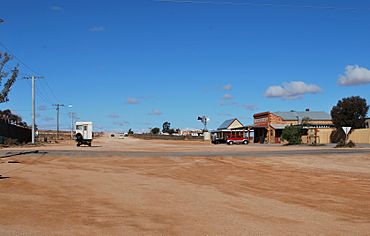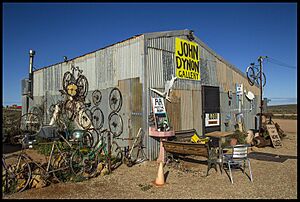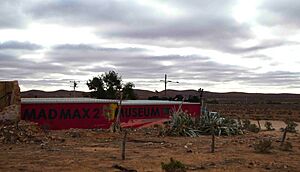Silverton, New South Wales facts for kids
Quick facts for kids SilvertonNew South Wales |
|
|---|---|

The main crossroads in Silverton, with the Silverton Hotel on the right
|
|
| Population | 48 (2021 census) |
| Postcode(s) | 2880 |
| Location |
|
| LGA(s) | Unincorporated Far West Region |
| State electorate(s) | Barwon |
| Federal Division(s) | Parkes |
Silverton is a small village in the far west of New South Wales, Australia. It is about 26 kilometers (16 miles) north-west of Broken Hill. In 2016, Silverton had a population of 50 people.
This town started when a lot of silver was found nearby. However, an even bigger discovery of silver, lead, and zinc happened in Broken Hill. This made many people leave Silverton. Some people call Silverton a ghost town. But it still has a small number of people living there. Most businesses now focus on tourists.
Contents
Silverton's Early History
The first people to live in this area were likely the Wiljakali people. They probably lived here only sometimes because there wasn't much water. Later, European explorers and settlers arrived.
European Explorers Arrive
The first European to visit the area was Major Thomas Mitchell in 1841. He was the Surveyor General of New South Wales. Three years later, in 1844, explorer Charles Sturt saw the Barrier Range. He named it because it blocked his path north.
The famous Burke and Wills also passed through here in 1860–61. They set up a base camp at nearby Menindee. Farmers, called pastoralists, started settling the area in the 1850s. They used the Darling River as their main trade route.
Finding Silver and Town Growth
People looking for minerals, called prospectors, started working here in 1867. A local worker claimed he found gold. But it turned out he just wanted to steal a horse.
In 1875, two men were drilling a well south of the town. They found a large amount of silver. Silverton was officially recognized as a town on September 17, 1880. Richard O'Connell became the police chief. He also handled many other important jobs.
In October 1886, the Silverton Municipal Council was formed. Their first meeting was in January 1887. The town's population grew quickly, reaching about 3,000 in the 1890s. The Silverton Tramway opened in 1888. It connected the town to South Australia.
Many houses were simple, made of iron and canvas. The silver ore around Silverton quickly ran out. Then, an even richer silver-lead-zinc deposit was found in nearby Broken Hill. This caused Silverton's population to drop suddenly. Many people even took their homes with them when they left.
Silverton in the 20th Century
By 1901, fewer than 300 people lived in Silverton. But it was still a popular place for picnics and outings from Broken Hill. In 1915, an incident known as the Battle of Broken Hill occurred. A New Year's Day picnic train from Broken Hill to Silverton was attacked.
Penrose Park: A Popular Spot
Penrose Park was a big attraction for these picnics. It was named after John Penrose, a brewer in Silverton. The park is next to Umberumberka Creek. It has rare green areas on the edge of Silverton. It became popular because of the mining boom in Broken Hill.
In 1893, it was meant to be a racecourse, but that didn't work out. For decades, it was a picnic ground. In the mid-1930s, mining companies in Broken Hill decided to improve it. They spent money on sports fields, playgrounds, and park areas.
Throughout the 1940s and 50s, it was a major recreation spot. Huge annual picnics and fairs were held there. For example, in 1941, one-fifth of Broken Hill's entire population attended a picnic there. So many cars drove to Penrose Park that the road became one of the first sealed roads outside Broken Hill.
By the mid-1960s, interest in the park began to fade. Support from the mining companies also decreased. The park slowly declined. Penrose Park is still there today. It is now a quiet public campground. It is popular with families and 'grey nomads' (older travelers). Many things from its busy past can still be seen there.
Who Lives in Silverton?
In the 2016 Australian census, Silverton had 46.9% males and 53.1% females. The average age was 53. There were 12 families living in 39 private homes. The average household income was $899 per week.
Silverton Today
Today, only about 50 people live in Silverton permanently. But its history and location make it a popular place for tourists. Several artists live in or near the town. These include Peter Browne, Albert Woodroffe, and John Dynon. Some of them have their own art galleries. Many artists also work in nearby Broken Hill. The desert landscape and light are great for creating art.
Most of the original buildings are now gone or in ruins. But some interesting buildings remain. These include the Silverton Hotel and the Silverton Gaol (jail). By 2007, Silverton had been used for over 140 films and commercials. This is because of the unique light, old colonial buildings, and scenic desert.
The Silverton Hotel has appeared in many movies. Its inside walls are covered with movie items. Some films include Razorback, The Adventures of Priscilla, Queen of the Desert, The Flying Doctors, and Dirty Deeds. A replica of the famous Mad Max car, the 'Interceptor', was outside the hotel from 2002. It has since been sold. Now, there is a privately owned Mad Max 2 Museum. It celebrates the movie filmed in the region. It has many movie items and two Interceptor replicas. The Silverton Hotel was also used in the TV series 800 Words.
Silverton Cemetery
Just outside town is the Silverton cemetery (GPS 31°52′27″S 141°13′54″E / 31.874259°S 141.231716°E). It has 402 identified grave sites. The cemetery covers an area of 42 acres (17 hectares).




